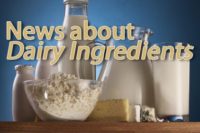Fortifying with Resistant Maltodextrin

Unfortunately, most Americans do not consume enough dietary fiber for good intestinal health. Interestingly, traditional dairy foods have low or no dietary fiber components, but are well accepted, consumer friendly and consumed in significant quantities on a daily basis by most everyone. Thus, dairy foods are prime candidates for fortification with dietary fiber to alleviate this fiber gap. However, not all dietary fibers are compatible with processed dairy foods nor with the processes used to make these foods.
Dietary fiber includes both water insoluble and soluble types. Insoluble dietary fibers are well known and have been used extensively for years in baked goods and a variety of other applications. Insoluble fibers are basic, inexpensive and compatible with the sensory characteristics of these types of products. They are not well adapted for use in processed dairy foods where flavor, color, body and texture are more subtle, and solubility is critical. More suited for dairy foods (fluid milks, milk drinks, juices, juice drinks, cultured products, frozen desserts, etc.) are the group of dietary fibers that are totally water soluble. Even within this group, not all soluble fibers work alike or work well. Amongst the water-soluble fibers, digestion-resistant maltodextrin (a.k.a. resistant maltodextin) such as Fibersol-2 from Matsutani America,is one of the most versatile of all dietary fibers for inclusion in processed dairy foods.
Resistant maltodextrin is completely water soluble, colorless, tasteless, odorless and totally compatible with virtually all processed dairy foods and dairy food processes. Resistant maltodextrin is inherently stable to high-heat and high-acid process conditions and is not fermented by organisms typically used in cultured dairy foods. In addition, resistant maltodextrin does not add any flavor of its own nor indirectly influence flavors added to or naturally occurring in foods. Finally, resistant maltodextrin aids in the performance of various high-intensity sweeteners making them more sugar-like in sweetness, flavor and mouthfeel.
Because of these properties, it is relatively easy to achieve significant fortification levels compatible with nutrient content claims and structure/function claims without sacrificing any sensory character of the finished food. To make a nutrient dietary fiber content claim such as a “good source of dietary fiber” (10% or more of the Daily Value) or an “excellent source of fiber” (20% or more DV), 2.5g or 5.0g dietary fiber, respectively, must be present per serving of the finished food. That’s enough fiber in three 8 fl oz servings of fiber-fortified fat free milk to fill the dietary fiber gap in the American diet. There is no sacrifice of finished product quality and the beverage drinks like whole milk. In addition, it all can be done at ingredient costs that do not exceed the cost of whole milk. That’s price-value.
Fluid dairy is not the only opportunity for new dairy product innovation. Cultured products such as yogurts, drinkable yogurts, kefir, cultured buttermilks, etc., can add to their already good-for-you image by not only enhancing the fiber content but also enhancing the development of beneficial microflora in the gut. Ice cream and frozen desserts can also take advantage of the unique nutritional and functional benefits of resistant maltodextrin.
All this makes resistant maltodextrin one of the most versatile, useful and economic water-soluble dietary fibers available for processed dairy foods.
Looking for a reprint of this article?
From high-res PDFs to custom plaques, order your copy today!




